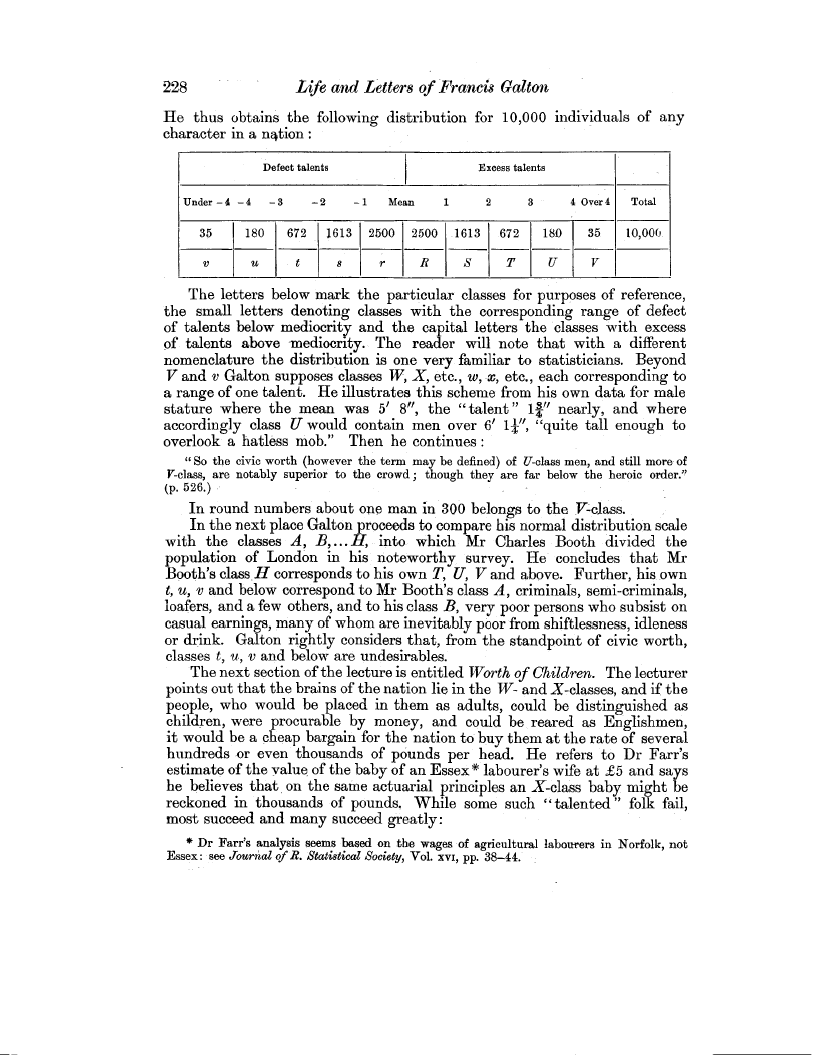| ||||||

OCR Rendition - approximate
228 Life and Letters of Francis Galton He thus obtains the following distribution for 10,000 individuals of any character in a nation
The letters below mark the particular classes for purposes of reference, the small letters denoting classes with the corresponding range of defect of talents below mediocrity and the capital letters the classes with excess of talents above -mediocrity. The reader will note that with a different nomenclature the distribution is one very familiar to statisticians. Beyond V and v Galton supposes classes W, X, etc., w, -x, etc., each corresponding to a range of one talent. He illustrates this scheme from his own data for male stature where the mean was 5' 8", the "talent" 11" nearly, and where accordingly class U would contain men over 6' 14", "quite tall enough to overlook a hatless mob." Then he continues "So the civic worth (however the term may be defined) of U-class men, and still more of V-class, are notably superior to the crowd ; though they are far below the heroic order." (p. 526.) In round numbers about one man in 300 belongs to the V-class. In the next place Galton proceeds to compare his normal distribution scale with the classes A, B,... H, into which Mr Charles Booth divided the population of London in his noteworthy survey. He concludes that Mr Booth's class_H corresponds to his own T, U, V and above. Further, his own t, u, v and below correspond to Mr Booth's class A, criminals, semi-criminals, loafers, and a few others, and to his class B, very poor persons who subsist on casual earnings, many of whom are inevitably poor from shiftlessness, idleness or drink. Galton rightly considers that, from the standpoint of civic worth, classes t, u, v and below are undesirables. The next section of the lecture is entitled Worth of Children. The lecturer points out that the brains of the nation lie in the W- and X-classes, and if the people, who would be placed in them as adults, could be distinguished as children, were procurable by money, and could be reared as Englishmen, it would be a cheap bargain for the nation to buy them at the rate of several hundreds or even thousands of pounds per head. He refers to Dr Farr's estimate of the value of the baby of an Essex* labourer's wife at £5 and says he believes that. on the same actuarial principles an X-class baby might be reckoned in thousands of pounds. While some such " talented " folk fail, most succeed and many succeed greatly: * Dr Farr's analysis seems based on the wages of agricultural labourers in Norfolk, not Essex: see Journal of R. Statistical Society, Vol. xvi, pp. 38-44.
| ||||||||||||||||||||||||||||||||||||||||||||||||||||||